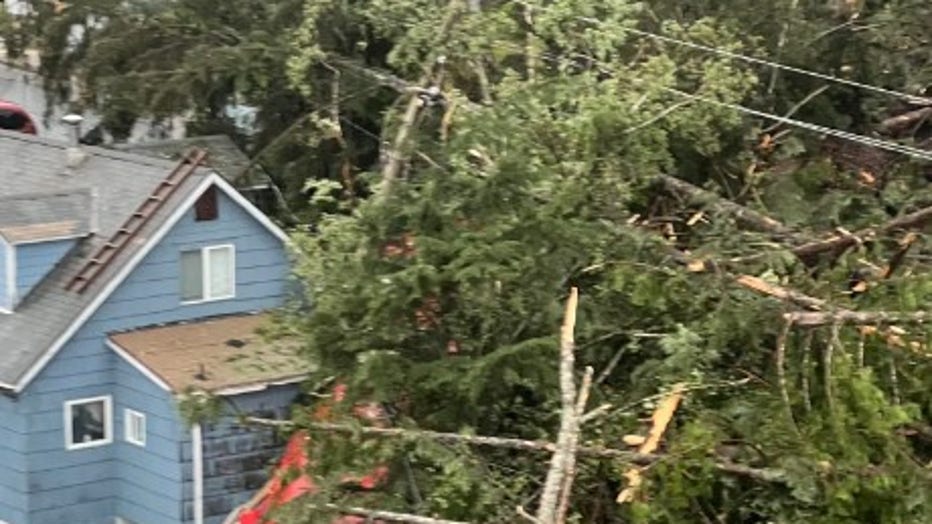Deadly landslide hits Ketchikan, Alaska: 1 killed, evacuations ordered

Emergency crews respond to deadly Alaska landslide
One person was killed and at least three injured after a landslide struck near homes in Ketchikan in southeast Alaska. (Credit: @zimrian via Storyful)
JUNEAU, Alaska - At least one person was killed, and three others were hurt after a landslide cut a path down a steep, thickly forested hillside and crashed into several homes in Ketchika, Alaska.
Mandatory evacuations were ordered of nearby homes in the city, a popular cruise ship stop along the famed Inside Passage in the Alaska panhandle.
The slope remained unstable Monday, and authorities said that state and local geologists were arriving to assess the potential for further slides.

"In my 65 years in Ketchikan, I have never seen a slide of this magnitude," Ketchikan Mayor Dave Kiffer said in a statement. "With the slides we have seen across the region, there is clearly a region-wide issue that we need to try to understand with the support of our State geologist."
RELATED: Rare tornado spotted in Alaska's Chugach State Park may only be state's 5th on record
He said the loss of life was "heartbreaking, and my heart goes out to those who lost their homes."
The landslide followed a weekend bout of rain amid an abnormally dry August, said Andrew Park, a meteorologist in Juneau with the National Weather Service. The weather service early Monday said Ketchikan had received about 2.6 inches (66 millimeters) of rain in about 36 hours, though rainfall totals at higher elevations nearby ranged from 5 to 9 inches (127 to 229 millimeters).
Landslides can be unpredictable, but this one occurred without certain other risk factors, such as high winds, Park said.
"There weren’t any of the big red flags we would normally see," he said.

Deadly landslide strikes homes in Alaskan city of Ketchikan
At least one person was killed and others were injured when a landslide struck homes in Ketchikan, Alaska, on August 25. (Credit: Ketchikan Gateway Borough via Storyful)
Ketchikan is surrounded by the Tongass National Forest, a temperate rainforest that encompasses much of southeast Alaska. Landslides often strike in the region, but garner little notice when they hit remote, unpopulated areas.
But as climate change intensifies storms and destabilizes soil, they are posing more risk to communities.
RELATED: Alaska landslide destroys homes in wake of soaking atmospheric river; 3 dead
Because of the steep terrain, there's limited room for development in the region, and cities and roads are built at the base of slopes. Increasingly, landslides are occurring in inhabited areas of "old infrastructure that’s been built in harm’s way," said Aaron Jacobs, a meteorologist and senior service hydrologist with the National Weather Service’s Juneau office.
"It’s just becoming more and more common that they’re impacting people," Jacobs said.
Alaska Gov. Mike Dunleavy declared an emergency for Ketchikan, while Kiffer and Ketchikan Gateway Borough Mayor Rodney Dial issued a separate emergency declaration. A shelter was set up at Ketchikan High School.
Two of the victims in Ketchikan were admitted to the hospital and one was treated and released. All other individuals were accounted for, the city and borough said in a joint statement.

Biden delivers remarks on climate action
President Joe Biden speaks on actions to combat climate change.
It wasn't immediately clear how many homes were damaged; the state transportation department was sending a drone operator to Ketchikan to help assess the slide.
Power was restored to some of the area by 8:15 p.m. Sunday. Other areas will remain without power while the landslide is cleared and broken power poles are replaced.
Landslides include debris flows often triggered by heavy rains. When logging or fire destroys trees, the loss of root structure can weaken soil. Rain that isn’t being sucked up by plants can saturate the ground, making it more likely to slide. Other types include creeps, which move slowly downward, and rock falls.
In Alaska, melting permafrost, retreating glaciers, earthquakes and pounding rains can all trigger landslides.

